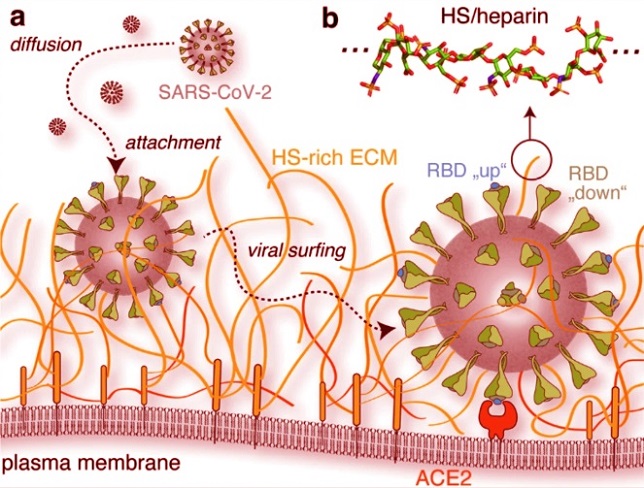Nikhil Prasad Fact checked by:Thailand Medical News Team Jan 02, 2025 3 months, 1 week, 4 days, 7 hours, 9 minutes ago
Medical News: Recent groundbreaking research has shed light on the role of heparan sulfate in SARS-CoV-2 infection, focusing on the evolutionary adaptations of the virus. Conducted by scientists from the University of Münster, the University of Milan, the University of Liverpool, and other prestigious institutions, the study delves into how these adaptations enhance the virus’s ability to infect host cells. This
Medical News report unpacks the key findings of the study, providing an accessible narrative for the general public.
 Schematic of SARS-CoV-2 host cell association and invasion. (a) There are four steps in virus-host interaction: Aerosol inhalation, attachment of viral particles to the ECM, diffusion of viral particles through the ECM (viral surfing), and viral entry through the cell membrane. SARS-CoV-2 attachment to the host cell ACE2 and viral entry require binding of HS (shown in orange) by trimeric S-proteins (green), which bind the virus to the HS-rich ECM environment and causes the RBD subunit of the S-protein to undergo a conformational change to an accessible conformation (from “down”, meaning hidden in the trimeric S1-protein, to the ACE2-accessible “up” conformation. (b) HS consists of up to 150 sugar residues, corresponding to chain contour lengths between 25 nm and 75 nm (and sometimes even up to 200 nm), and is highly negatively charged.
The Role of Heparan Sulfate in SARS-CoV-2 Infection
Schematic of SARS-CoV-2 host cell association and invasion. (a) There are four steps in virus-host interaction: Aerosol inhalation, attachment of viral particles to the ECM, diffusion of viral particles through the ECM (viral surfing), and viral entry through the cell membrane. SARS-CoV-2 attachment to the host cell ACE2 and viral entry require binding of HS (shown in orange) by trimeric S-proteins (green), which bind the virus to the HS-rich ECM environment and causes the RBD subunit of the S-protein to undergo a conformational change to an accessible conformation (from “down”, meaning hidden in the trimeric S1-protein, to the ACE2-accessible “up” conformation. (b) HS consists of up to 150 sugar residues, corresponding to chain contour lengths between 25 nm and 75 nm (and sometimes even up to 200 nm), and is highly negatively charged.
The Role of Heparan Sulfate in SARS-CoV-2 Infection
Heparan sulfate (HS) is a sugar chain that decorates the surface of cells, playing a crucial role in viral infections. It acts as a docking site, facilitating the attachment of SARS-CoV-2 to host cells. This interaction is a prerequisite for the virus to reach its primary receptor, angiotensin-converting enzyme 2 (ACE2), and initiate infection. The spike protein of SARS-CoV-2, a trimeric structure responsible for host cell binding, interacts strongly with the negatively charged HS. Over time, variants of the virus, such as Omicron, have developed modifications in the spike protein to enhance this interaction.
The study explores how these changes in the spike protein influence both the binding dynamics with HS and the virus’s mobility across the extracellular matrix, key factors in infection efficiency.
Study Methods and Key Discoveries
Using advanced molecular modeling, biochemical assays, and surface interaction studies, researchers meticulously examined the spike protein interactions of three SARS-CoV-2 variants: Wuhan, Delta, and Omicron. The primary focus was on how these interactions evolved to optimize the virus’s ability to bind and move within the HS-rich environment.
Enhanced Binding and Mobility
The study revealed that the Omicron variant’s spike protein has evolved to simultaneously achieve two seemingly conflicting goals - strong HS binding and efficient movement through the extracellular matrix. By introducing positively charged amino acids, the Omicron spike protein can bind more strongly to HS, enhancing initial attachment. However, it also maintains a dynamic interactio
n that allows it to “surf” along HS chains without detaching entirely. This mobility is critical for locating ACE2 receptors on host cells, a necessary step for successful infection.
The Role of Cross-Linking
A significant finding was the ability of the Omicron spike protein to cross-link multiple HS chains. This cross-linking facilitates viral movement by allowing the virus to “slide” between chains rather than becoming trapped. The researchers demonstrated this using artificial HS-functionalized surfaces, where the Omicron variant exhibited superior mobility compared to earlier variants. This dynamic binding mechanism underscores a sophisticated evolutionary adaptation.
Pharmaceutical Implications
Interestingly, the study also identified a potential therapeutic avenue. A pharmaceutical HS mimic, pentosan polysulfate (PPS), showed promising results in inhibiting Omicron’s ability to bind to cell surfaces. By targeting the enhanced HS interactions of the Omicron variant, PPS effectively reduced the virus’s ability to initiate infection. This finding opens new possibilities for antiviral strategies, particularly against highly transmissible variants.
Evolutionary Implications of SARS-CoV-2 Adaptations
The evolutionary trajectory of SARS-CoV-2, particularly the Omicron variant, highlights how the virus has fine-tuned its interaction with host cell components. While the stronger binding to HS increases the chances of initial attachment, the enhanced mobility ensures efficient infection. These adaptations have likely contributed to Omicron’s dominance as a global variant, characterized by increased transmissibility and a shift toward infecting the upper respiratory tract.
Conclusion
This research provides profound insights into the molecular strategies employed by SARS-CoV-2 to enhance infectivity. By evolving to optimize HS interactions, the virus has achieved a delicate balance between stable attachment and dynamic mobility. These findings not only deepen our understanding of viral evolution but also pave the way for novel therapeutic interventions. Targeting the HS binding mechanism could offer a robust strategy to combat current and future variants.
The study findings were published in the peer-reviewed journal: Scientific Reports.
https://link.springer.com/article/10.1038/s41598-024-84276-5
For the latest COVID-19 News, keep on logging to Thailand
Medical News.
Read Also:
https://www.thailandmedical.news/news/breaking-omicron-will-wreak-havoc-on-your-body-weeks-later-as-it-can-bind-to-cells-using-cellular-polyanionic-receptors-like-heparan-sulfate
https://www.thailandmedical.news/news/heparan-sulfate-and-enoxaparin-show-promise-against-covid-19
https://www.thailandmedical.news/news/covid-19-research-university-of-california-study-shows-that-heparan-sulfate-assists-sars-cov-2-coronavirus-to-bind-to-ace2-and-enter-human-host-cells
https://www.thailandmedical.news/articles/coronavirus
